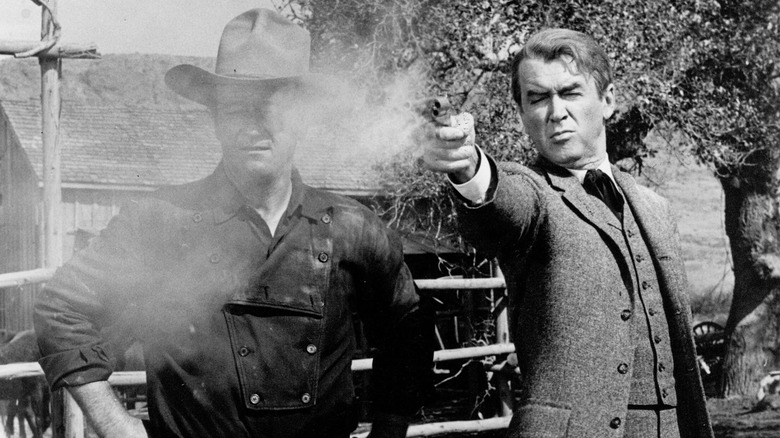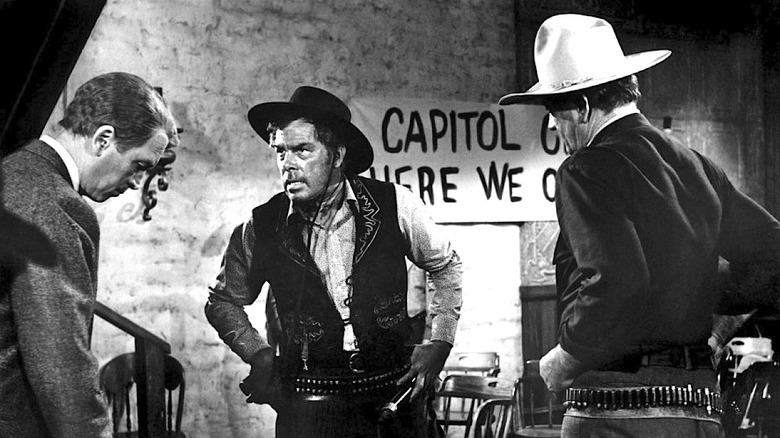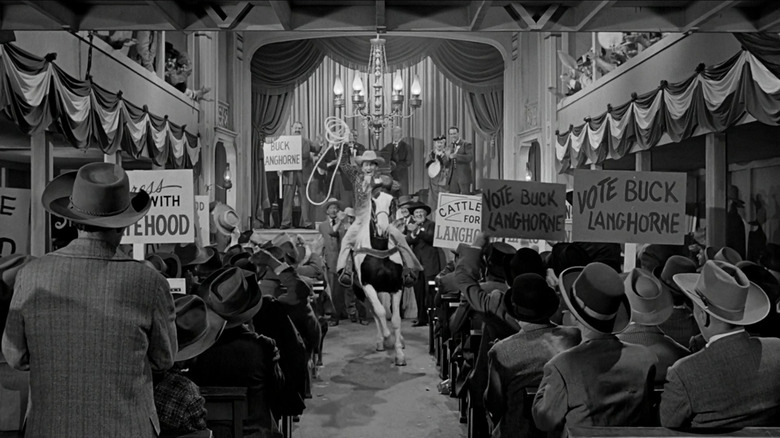John Ford Made The Man Who Shot Liberty Valance Miserable For Everyone Involved
John Ford's Western films have agreed with audiences around the world, but the same cannot be said for his attitude. As the acclaimed filmmaker aged, his temper sharpened and his patience thinned. This more crotchety he became, the less sway his name held. It didn't help that Hollywood's studio structure, once burgeoning with funds and talent, was aging along with him.
One of the last films of Ford's career was "The Man Who Shot Liberty Valance," a Paramount picture with a star-studded cast that included two staples of the studio era, John Wayne and Jimmy Stewart. The film was released in 1962, at a time when Hollywood's well-oiled machine was beginning to fall apart. Movies simply were not as profitable as they once were, and stars became a bigger point of attraction than ever. This meant studios had to spend more money paying their talent than on production costs. This context set the stage for the tense set of "Liberty Valance."
"Liberty Valance" was notably shot on sound stages, rather than in the desert landscapes Ford typically incorporated into his films, such as 1956's "The Searchers." The film was also shot in black and white rather than color. Both choices, according to cinematographer William Clothier, were made explicitly for financial purposes. "Paramount was cutting costs," Clothier explained, and Ford was forced to either "accept [the] terms or not make the film" (via Michael Munn's 2005 book, "John Wayne: The Man Behind the Myth"). The limitations definitely soured his passion for the project, and "when the time came to start work on it, he had already lost interest."
Wayne and Paramount bruised Ford's ego
One cost that did not appear to get cut was John Wayne's salary. In fact, Paramount insisted they would not fund the production unless John Ford was able to get Wayne onboard. This created a palpable tension between the two collaborators. Ford "didn't want [Wayne] to think he was doing him any favors," actor Lee Van Cleef explained in the book. With his pride damaged, Ford felt the need to put Wayne in his place.
Wayne was often the leading man of Ford's films, but the director was determined to use the actor as little as possible in "Liberty Valance." Consequently, Wayne took a backseat to Jimmy Stewart and Lee Marvin. This left Wayne feeling like "a background prop," seriously neglected. He insists he "didn't mind playing second fiddle for a change," but that the role was so small and insignificant to the story it gave him "nothing to go on." What's more, Van Cleef said Ford would regularly "abuse [Wayne] and swear at him and call him a 'goddamn lousy actor.'" Because Wayne was the reason the film got made, he bruised Ford's ego and made himself the subject of the old man's ire.
Jimmy Stewart wasn't safe either
John Ford had a personal score to settle with John Wayne, but that didn't stop him from lashing out at the other actors as well. The director had a habit of pushing well-intentioned people into putting their foot in their mouth, and his bad mood on the set of "Liberty Valance" only exacerbated the tendency.
Mild-mannered Jimmy Stewart was the perfect target for Ford's bullying. Gearing up for a scene where Woody Strode was dressed in old-man garb, Ford asked for Stewart's opinion on Strode's wardrobe, who responded that it felt "a bit Uncle Remussy" (via Express). Stewart was referencing the main character from Disney's 1946 film "Song of the South," a controversial caricature that often narrated Black folktales in popular media. A devilish Ford retorted, "What's wrong with Uncle Remus?" He then called the rest of the crew together and told them what Stewart had said, adding: "Now, I don't know if Mr. Stewart has a prejudice against Negroes, but I just wanted you all to know about it."
Thoroughly embarrassed, Stewart "wanted to crawl into a mousehole," but he found camaraderie with Wayne. "Well, welcome to the club," Wayne consoled him, "I'm glad you made it." Both the actors were victims of some pretty harsh treatment from Ford, but a silver lining was the solace that they took in one another. The set of "Liberty Valance" was certainly a tense environment, but it's pleasant to know that Ford's negative attitude didn't contaminate the relationships between the actors.


